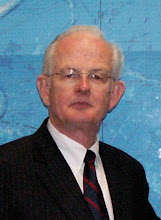Thursday, July 12, 2012
Monday, January 9, 2012
"The House of the Lord - Holiness to the Lord"
The following pronouncement is to be found on the exterior of each temple constructed and dedicated by The Church of Jesus Christ of Latter-day Saints: "The House of the Lord - Holiness to the Lord." The question may be asked, to whom do we have reference when we use the word "Lord" in this instance? Are we referring to God the Father or to His Son, Jesus Christ? The answer is, we have reference to both the Father and the Son. There is no reason to believe that the title Lord used in this context must refer to one or the other exclusively.
While the title Lord as used in our standard works refers much more frequently to Jesus Christ than it does to our Heavenly Father, what is important to keep in mind is that Lord is a proper reference for both. In most cases, the scripture’s context will resolve any question that may exist as to whether Elohim or Jehovah is being referenced. The Psalmist illustrates the case in point when he wrote, “The Lord said unto my Lord, Sit thou at my right hand, until I make thine enemies thy footstool” (Psalm 110:1). During His mortal ministry, Jesus Christ elaborated on this verse of scripture. “While the Pharisees were gathered together, Jesus asked them, Saying, What think ye of Christ? whose son is he? They say unto him, The Son of David. He saith unto them, How then doth David in spirit call him Lord, saying, The Lord said unto my Lord, Sit thou on my right hand, till I make thine enemies thy footstool? If David then call him Lord, how is he his son? And no man was able to answer him a word, neither durst any man from that day forth ask him any more questions” (Matthew 22:41-46).
In Section 93 of the Doctrine and Covenants, we find an interesting reference to the Deity that clearly has reference to both the Father and His Son. After quoting verses from the writings of John the Baptist to the Prophet Joseph Smith, the Lord continued: “I give unto you these sayings that you may understand and know how to worship, and know what you worship, that you may come unto the Father in my name, and in due time receive of his fulness” (D&C 93:19). Individually our eventual obtaining of eternal life, according to the Savior, is dependent upon our proper understanding of who we worship and how we are to worship them; Gods plural.
In his recent dedicatory prayer for the Quetzaltenango Guatemala Temple, President Dieter F. Uchtdorf said, “We thank Thee for the knowledge Thou hast given us of Thee and of Thy Beloved Son, our Lord Jesus Christ. We thank Thee for the Prophet Joseph Smith through whom Thou hast restored Thy Holy Priesthood and eternal gospel principles, practices, and keys that will be exercised in this Thy holy house. We thank Thee for a living prophet in our days, even President Monson; we love him and we pray for him. . . . And now, acting in the authority of the everlasting priesthood, and as Thy commissioned servants, we dedicate to Thee and Thy Beloved Son the Quetzaltenango Guatemala Temple of The Church of Jesus Christ of Latter-day Saints” (Church News, December 17, 2011, p. 5). Here is a clear and unmistakeable reference to a temple being dedicated to both the Father and His Son.
In his November 1980 dedicatory prayer for the Seattle Washington Temple, President Spencer W. Kimball said, “Our Holy Father in Heaven, Thou who hath created our spirits and the heavens and the earth and all things therein, in the worthy name of thy greatly Beloved Son, Jesus Christ, we come to Thee this day in this beautiful edifice to dedicate it unto Thee, our Living God. . . . And now, by the power of the Holy Priesthood Thou hast given us, we dedicate this building and all that pertains to it, together with all its furnishings and contents, to Thee, our Holy Father, and ask Thee to accept it and shower blessings upon it, in the worthy name of Thy Beloved Son, Jesus Christ, our Redeemer.” In this prayer quite clearly, the emphasis of dedication was made to the Father in the name of His Son.
Lest this or any other prayer of temple dedication move us to conclude that a “House of the Lord” be intended for only one or the other of the two Gods whom we worship, let us recall the words of the Prophet Malachi: “Behold, I will send my messenger, and he shall prepare the way before me: and the Lord, whom ye seek, shall suddenly come to his temple, even the messenger of the covenant, whom ye delight in: behold, he shall come, saith the Lord of hosts” (Malachi 3:1). We popularly accept in this dispensation that the words of Malachi were fulfilled by the Savior’s appearance to His temple on April 3, 1836 to the Prophet Joseph Smith and Oliver Cowdery in Kirtland, Ohio. “Let the hearts of your brethren rejoice, and let the hearts of all my people rejoice, who have, with their might, built this house to my name. For behold, I have accepted this house, and my name shall be here; and I will manifest myself to my people in mercy in this house” (D&C 110:6-7).
Remembering the counsel of the Lord to the Prophet Joseph Smith as contained in Section 93, we should seek opportunity to better understand how we are to worship and who we worship that we might someday be found worthy of eternal life. What better place to do this than in “The House of the Lord.”
